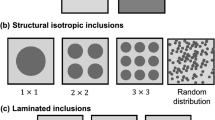Abstract
The life time or time to failure of rocks under load is governed by microstructural defects, like microcracks, voids etc. The life time can be predicted either by empirical exponential laws or physical laws based on damage and fracture mechanics. The proposed numerical model is based on subcritical crack growth using the linear elastic fracture mechanical approach and is implemented as a numerical cellular automate. The algorithm considers both tensile and shear fracturing. Each cell contains a microcrack of random length according to a given probability function. Fracture growth is controlled by the Charles equation. Macroscopic cracks are the results of the coalescence of growing microcracks. Within the numerical approach elasto-plastic stress redistributions take place. If the stress intensity factors have reached the critical values or the microcrack has reached the zone dimension, the zone is considered as fractured and residual strength values are assigned. The proposed approach was applied to rock samples under uniaxial compressive and tensile loads (creep tests). Successful results were obtained in respect to the predicted life time, damage evolution and the fracture pattern. Conclusions for further improvements and extensions of this methodology were drawn.






Similar content being viewed by others
References
Atkinson BK (1987) Fracture mechanics of rock. Academic Press, London, p 534
Caruso H, Dasgupta A (1998) A fundamental overview of accelerated testing analytical models. J IEST 41(1):16–20
Eyring H (1936) Viscosity, plasticity, and diffusion as examples of absolute reaction rates. J Chem Phys 4:283–291. doi:10.1063/1.1749836
FLAC (2005) Itasca Consulting Group. Minneapolis, Minnesota
Guedes RM (2006) Lifetime prediction of polymer matrix composites under constant or monotonic load. Composites Part A 37:703–715. doi:10.1016/j.compositesa.2005.07.007
Shin K et al (2005) Variation in strength and creep life of six Japanese rocks. Int J Rock Mech Min Sci 42:251–260. doi:10.1016/j.ijrmms.2004.08.009
Sulzer AI (1976) Der Zerstörungsvorgang in Festkörpern. In: Balarin M (ed) Festkörperphysik—Entwicklungstendenzen und Anwendungsmöglichkeiten. Akademie-Verlag, Berlin, pp 224–247
Zhurkov SN (1965) Kinetic concept of the strength of solids. Int J Fract Mech 1(4):311
Acknowlegment
The authors thank the anonymous reviewer for the hints and remarks, which have contributed to improve the quality of the paper.
Author information
Authors and Affiliations
Corresponding author
Rights and permissions
About this article
Cite this article
Konietzky, H., Heftenberger, A. & Feige, M. Life-time prediction for rocks under static compressive and tensile loads: a new simulation approach. Acta Geotech. 4, 73–78 (2009). https://doi.org/10.1007/s11440-009-0085-4
Received:
Accepted:
Published:
Issue Date:
DOI: https://doi.org/10.1007/s11440-009-0085-4




